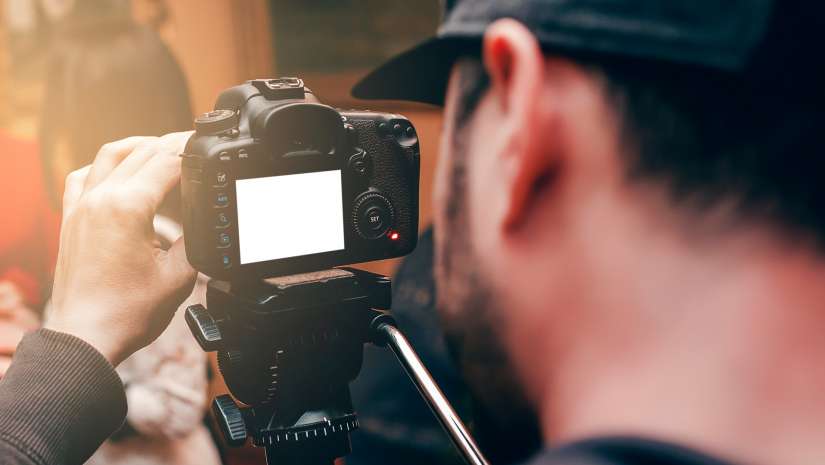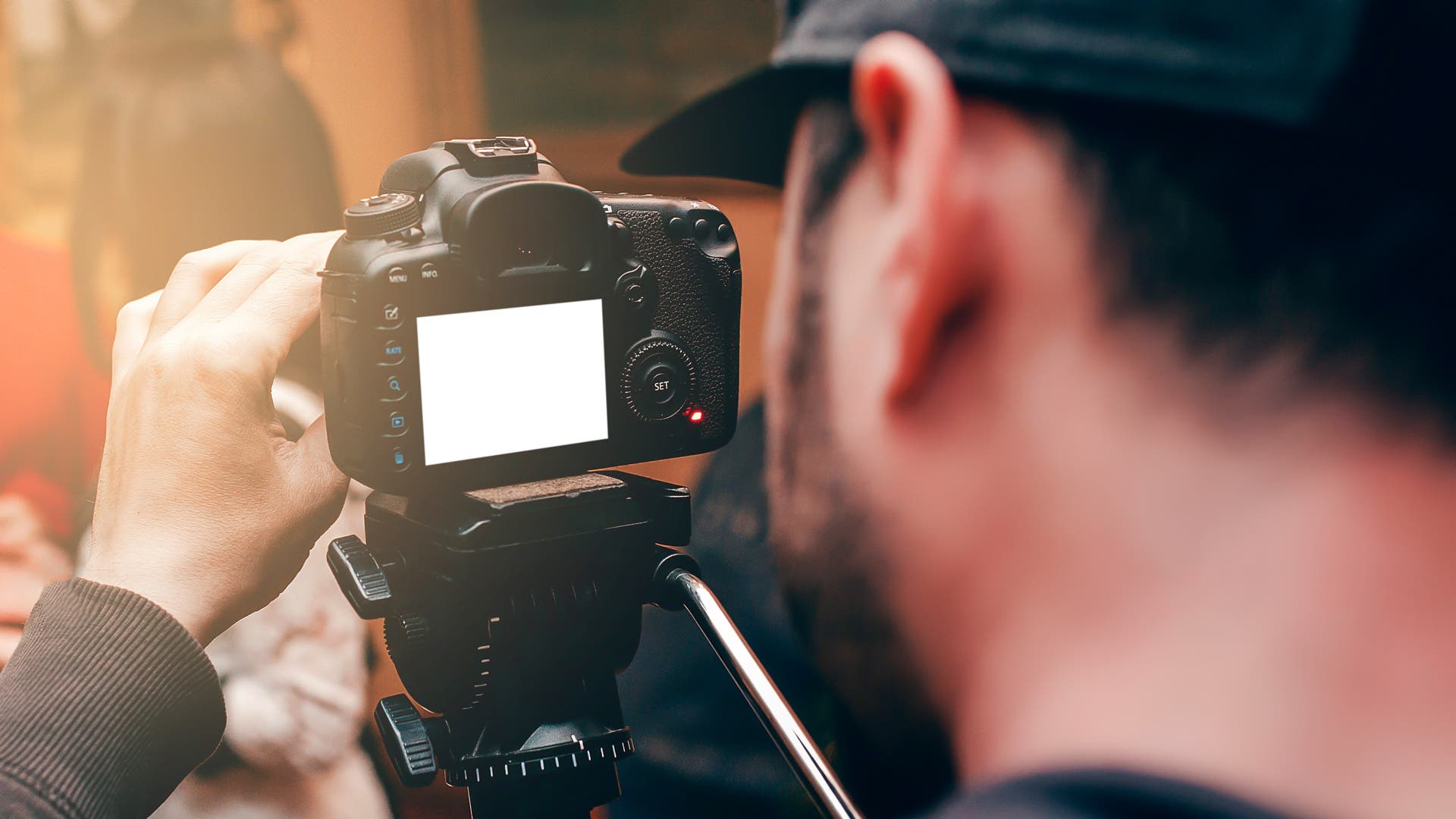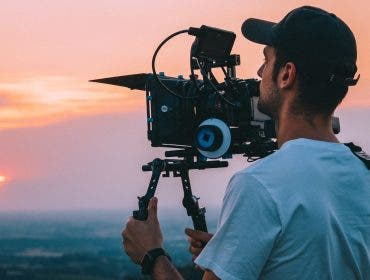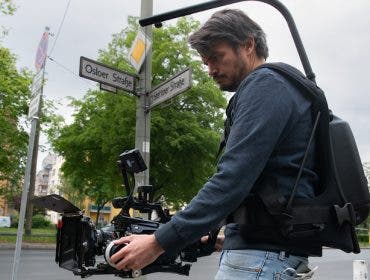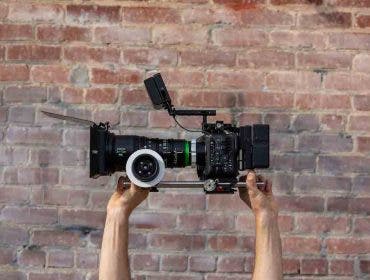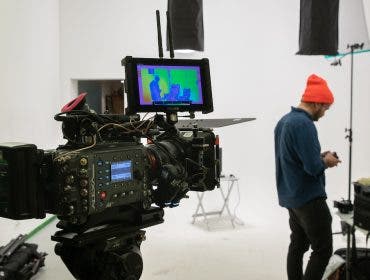The videos that are coming out of today’s DSLRs or mirrorless cameras are phenomenal and in many cases can compete with the big boys of cinema cameras. However, there are many ways to get even better video out of your camera. Investing in the right video camera accessories can bring your filmmaking to the next level.
Below are 11 different types of video camera accessories which will help you to create better videos. The list contains some inexpensive and some relatively expensive add-ons. When making this list, I tried to keep to the lower end of the price scale, as many people buying a DSLR or mirrorless for video are looking to keep expenses under control and slowly build up their kit.
Best Video Camera Accessories for DSLRs & Mirrorless Cameras
1. Tripods
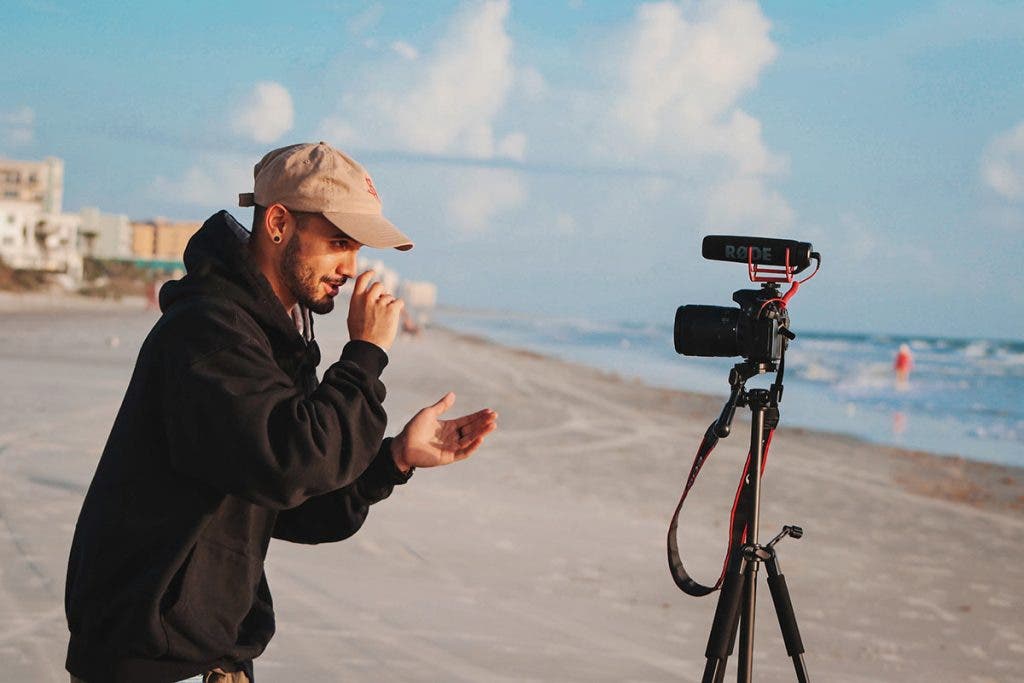
The first of the video camera accessories you should look into getting is a tripod, or at the very least a monopod. No matter how much image stabilization you have or how steady you think you are handholding your camera, you need a tripod if you are after smooth pans and tilts. Tripod legs for video vary wildly in price based on material (generally titanium, carbon fiber or aluminum), manufacturer, minimum and maximum height, carrying capacity, locking mechanisms and whether or not a head is included. Tripod heads also vary wildly in price based on manufacturer, type of fluid head, whether or not it is a bowl mount, carrying capacity, and whether or not it is a counterbalanced head.
The first question to ask yourself is what type of video are you planning on shooting? If you are an event videographer, you may need tripod legs that extend very high to get over the heads of people in the crowd. If you are planning on shooting travel videos, weight and compression ratio (how small the tripod is when collapsed versus fully extended) are the most important factors.
Manfrotto Nitrotech 612 Series Fluid Video Head with 635 FAST Single Leg Carbon Fiber Tripod
For a super-sturdy yet extremely portable tripod, check out the Nitrotech 612 by Manfrotto. The tripod legs are composed of carbon fiber, so they’re incredibly lightweight while still providing an impressively solid base for a variety of shots.
The Nitrotech 612 and included Fluid Video Head contain a continuous counterbalance system with a nitrogen piston mechanism, so it’s easy to make small, precise adjustments.
Whether you’re shooting indoors or on rugged outdoor terrain, this tripod delivers dependable stability and versatility. Choose from spiked feet for outdoor locations or wide rubber overshoes for indoor flooring.
If you’re looking for a ready-to-go tripod system for video, this is the ideal choice.
Sachtler 1001 Ace M MS System
Sachtler makes amazing tripods and until the last few years, they were all in the $1K+ price range. With the Ace range of tripods, Sachtler has brought their amazing quality to the mid-priced tripod market. You really can’t go wrong with either of these tripods.
Tripod Head
Manfrotto 504X Fluid Video Head with Flat Base
If you already have a set of tripod legs that you love, consider investing in a new tripod head to elevate your video capabilities.
The Manfrotto 504X Fluid Video Head features a four-step counterbalance system for effortlessly smooth panning and tilting. An onboard bubble level and sliding quick-release plate speed up tripod setup, so you can start shooting quicker than ever.
If the 504X is a bit beyond your budget, the Manfrotto 500 Fluid Video Head is an affordable substitute with a small reduction in features. Consider pairing either of these tripod heads with the Manfrotto Move Quick Release System for even more flexibility during shoots.
Bonus info:
For those photographers out there who have spent good money on tripod legs, you don’t necessarily need to go out and buy a new set. You can mount the fluid head of your choosing to your current legs and for those who want quick leveling, you can use the Manfrotto 438 Compact Leveling Head, which attaches between the center column of your legs and the head to quickly level your camera.
2. Audio
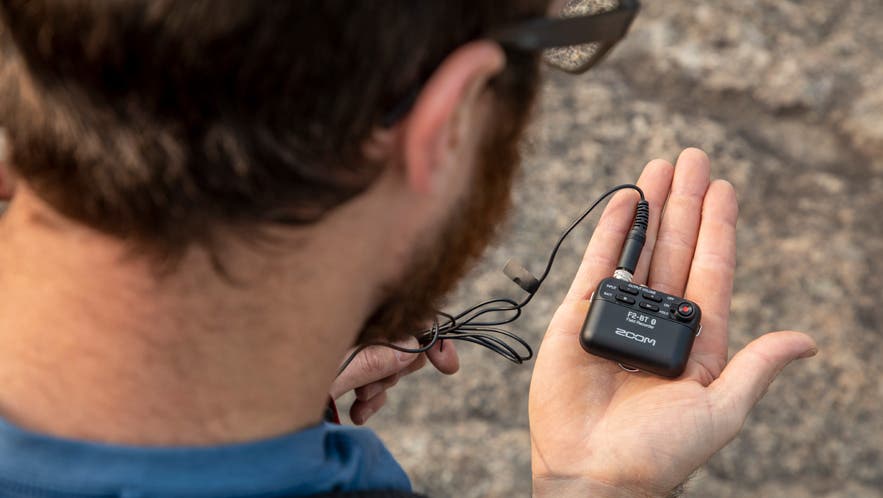
Having great video is not solely about the picture, but also about the auditory experience. Making sure that you are recording good audio should be as important, if not more so, than making sure your image is outstanding. Capturing excellent audio is an art of its own and many projects require a dedicated sound person, however there are definitely circumstances where the budget doesn’t allow for an extra crew member.
For those times where you need to get high quality audio, the internal microphone on your DSLR or mirrorless will simply not do the job. Try to keep audio equipment limited as you work to minimize gear including video camera accessories.
Wireless
Rode Wireless GO II Compact Microphone System
Wireless microphone systems save time and energy during a video shoot. Rather than worrying about hiding wires and keeping long audio cables on hand, you can focus on optimal microphone placement with a wireless mic.
Rode’s Wireless GO II Compact Microphone System is a great option for videographers. This kit includes two transmitters with built-in microphones and a single receiver. Flexible outputs let you attach the receiver to your camera, computer, or audio recorder.
As an added bonus, the Wireless Go II system is future proof thanks to a computer-ready USB-C port. Just plug the transmitters and receiver into your computer for firmware upgrades and easy charging.
Sennheiser ew 112P G4 Camera-Mount Wireless Omni Lavalier Microphone System
Sennheiser offers another great wireless microphone option for videographers with the ew 112P G4 Lavalier system. These microphones feature a more traditional lavalier format, with a wired clip mic that attaches to a bodypack transmitter.
This kit includes a single transmitter, an ME 2 lavalier omnidirectional microphone, a camera receiver, and all the cables and video camera accessories you’ll need to produce great audio for your productions. With a transmission range of up to 100 meters, you can easily capture sound from any location.
Sennheiser is one of the top brands in audio recording, so you can feel confident this microphone system will produce high-quality, authentic sound for any film project.
Microphone
Rode NTG5 RF-Bias Broadcast Shotgun Microphone
Rode’s NTG5 RF-Bias Broadcast Shotgun Mic is designed for absolute simplicity. With a lightweight and compact body, this shotgun microphone is easy to transport and carry to far-flung filming locations while providing professional quality audio.
A highly directional supercardioid polar pattern means you won’t have to worry about background noise. Just point the mic toward the audio source you want to capture and start recording.
Whether mounted at the end of a boom pole or on top of your camera, the NTG5 is rugged and safe to use in a variety of conditions. The RF-bias circuitry and conformal coating offer impressive protection against inclement weather.
Sennheiser MKH-416 Shotgun Tube Microphone
Achieve professional-quality audio with the Sennheiser MKH-416 Shotgun Tube Microphone. Featuring a hypercardioid polar pattern at lower frequencies and a lobar pattern at higher frequencies, this mic allows you to capture a variety of sound sources without worrying about excessive background noise.
The RF condenser design makes it possible to shoot outdoors in humid environments with minimal concern about moisture and condensation impacting the quality of your audio. The included windscreen is all you need for managing audio recording on windy days.
The MKH-416 uses phantom power. Recording is straightforward with any audio recorder or camera that has a built-in preamp.
Rode Microphones VideoMic Pro
The VideoMic Pro from Rode allows you to capture significantly cleaner and clearer audio than the internal mic on your camera. With a shock mount, high pass filter, and option to reduce the input level by -10 dB or increase it by +20db, this mic gives you a lot of control in a small package that fits atop your camera.
The +20dB boost can be a lifesaver when dealing with the noisy pre-amplifier in your camera. The audio, while much better, is still however limited, as when it is attached to the hot shoe of your camera it is not likely super close to your subject.
When your subject is far from the camera and isn’t moving very much, such as in an interview setup, you can attach this microphone to a stand for better audio. Simply connect it to an external audio recorder and make sure to run sound from the internal mic of your camera in order to more easily synch the sound in the edit. Whenever you start a new take make sure to either use a slate or just clap loudly in order to make syncing easier.
Recorder
Zoom H4n Pro 4-Input/4-Track Portable Handy Recorder
When you want to add flexibility to your audio setup, incorporating a portable recorder is a great idea. The Zoom H4n Pro is a robust, yet affordable video camera accessories option for high-quality audio capture.
One feature that makes this recorder unique is the helpful Pre-Record function. It captures two seconds of audio before you start recording, so if you accidentally miss a cue, you can still capture the take.
The Zoom H4n Pro offers three recording modes — Stereo Mode, 4-Channel Mode, and MTR Mode — so no matter what your project entails, you have plenty of options for capturing high-fidelity audio.
Zoom F6 Multi-Track Field Recorder
Videographers who appreciate the latest gear and upgrades will love the Zoom F6 Multi-Track Field Recorder.
This is the first professional-grade field recorder to offer 32-bit float recording and dual AD converters. That means you can record subtle audio and loud sounds at impressive quality levels without needing to adjust your sound levels.
Zoom’s on-board AutoMix technology adjusts mix levels automatically while recording so you can capture all the audio you want while limiting undesirable ambient noise.
If you’re looking for some of the best audio technology on the market, nuanced controls usually found on full-size sound consoles, and an ultra-portable body, this is the recorder for you.
3. Lighting
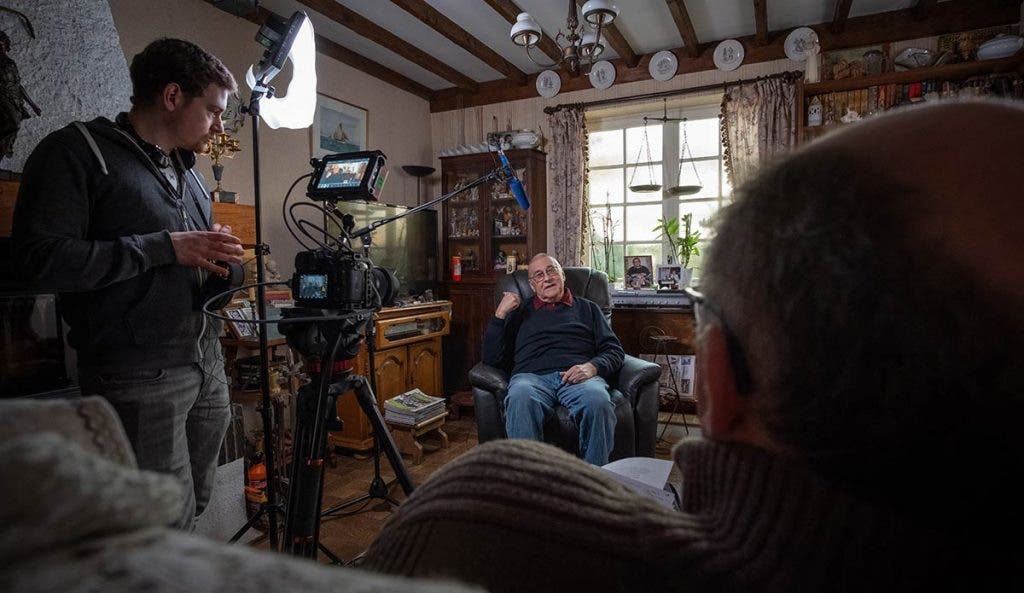
Probably the number two difference, after audio quality, between good and great videos is the attention paid to lighting and composition. The needs of lighting vary wildly from one setup to another, from one shooting style to another. But cinematography lighting techniques are critical for good videos. Luckily the price for lighting has been significantly reduced over the last few years with the advent of LED lighting for video.
Depending on what you plan to record you may need a lot of lighting equipment or you may need just a simple light set for a three point lighting setup. For those on a budget, start out with a few LED panels that will work for interviews or to get a bit more light on your subject.
Creamsource Vortex8 2×1 RGBW 650W LED Light
Versatility and performance help designate Creamsource’s Vortex8 2×1 RGBW LED Light fixtures as standout favorites among the filmmaking community.
These LED lights are strong enough to simulate daylight while shooting indoors, but you can also pair them with a range of diffusers and video camera accessories for soft, creamy lighting. The Vortex8 is a robust choice for filming in a variety of atmospheric or simulated weather conditions thanks to a sealed, water-resistant case.
You can use the Vortex8 with a range of lighting consoles, computer programs, and other controllers thanks to Ethernet, Bluetooth, 5pin DMXm WiFi, USB, and LumenRadio TimoTwo connectivity.
Yongnuo YN-216 3200-5500K Dimmable LED Video Light
Another bi-color, battery powered light from Yongnuo is one of the top video camera accessories. This one really packs quite a punch and can be used as a hair light or background light. Using diffusion, you can also find many uses for this light. You can also use black wrap to create a snoot which directs the light to a smaller area.
Aputure Light Storm 1200d Pro 1200W Daylight LED Light
Enjoy impressive range and control with Aputure’s Light Storm 1200d Pro. This flagship LED combines the highest light output on the market with the versatility of Bowen’s mount. Easily swap among the included wide 55°, medium 30°, and narrow 15° reflectors to control the shape and look of your light.
The LED fixture is calibrated to a daylight color temperature of 5600K, so you never have to worry about applying gels or spending too much time tweaking color temperatures in post production.For involved shoots requiring practical battery-powered light sources, consider supplementing your Light Storm 1200d Pro with the Astera 8xFP1 Titan Tube Lights.
4. Lenses
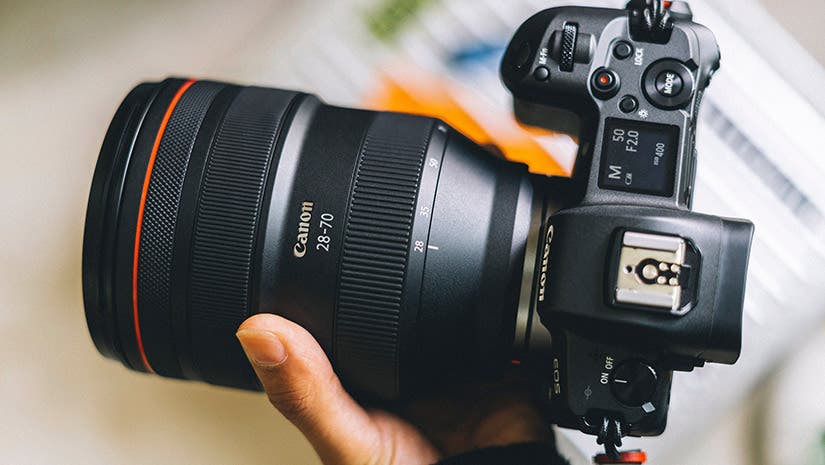
Your selection of lenses will make a big impact on the quality of your image and are must-have video camera accessories. The first consideration you will need to make when selecting lenses is which focal lengths you will need. If you are filming landscapes you will likely want to have wider lenses, such as an 18mm or 24mm lens. If you are filming cityscapes with a focus on people you may look to more normal lenses such as 35mm or 50mm lenses. When you want to capture far away action such as sports videos you will need a telephoto lens, such as a 200mm or greater lens.
Budding videographers with Canon cameras and systems have plenty of great lens options to choose from, both for EF/EF-S DSLR systems, and for RF mirrorless systems. Sony-focused filmmakers can take advantage of some of the best lenses on the market for shooting at wide apertures with gorgeous clarity and bokeh.
Prime vs Zoom Lenses
If you are shooting video and you will be shooting at many different focal lengths the next choice you will have is between prime lenses or zoom lenses. Each has benefits and drawbacks in our list of video camera accessories. The best primes are sharper than the best zooms at the same focal length. Primes are also almost always cheaper and easier to find with a faster maximum aperture.
The benefits of zooms is that switching between focal lengths is significantly faster than switching between primes, you have less weight and space requirements, and it can be cheaper to get one zoom lens that covers the same focal range of a set of prime lenses and the zoom will also include all the focal steps in-between the prime range.
Wedding videographers often prefer to shoot with zoom lenses thanks to their flexibility. When you need to keep a respectful distance from important wedding day moments, but need to capture clear, tight footage, nothing beats a zoom lens.
Best Lenses for Camera Sensor Size
Your lens choice will also be dictated by your camera’s sensor size. Is your camera’s sensor micro 4/3, APS-C, full frame? Lenses usually come in a specific mount based on camera manufacturer, however there are now several ways to adapt lenses from one manufacturer to a camera from another. There are also adapters that can communicate focus and aperture information to the camera from the lens. On top of that there are also now adapters called speed boosters which allow full frame lenses to work on cropped sensor cameras while also gaining a fraction of a stop in brightness, truly an amazing new technology.
Best Lenses for Video
As you have a DSLR or mirrorless camera, photo lenses will be your first pick as video camera accessories. While photo lenses can definitely be used for filming, they definitely have drawbacks that should be understood before being purchased for use in video.
Most currently manufactured photo lenses are auto-focusing and aren’t designed for precise manual focusing. The focusing ring of most photo lenses will spin continuously and don’t have hard stops for near and far focus. They also generally have a very small angle of barrel rotation between the near and far focusing points. These factors leads to difficulty in performing smooth, repeatable focus pulling with precision. This doesn’t mean it can’t be done, it just means that in comparison to cine lenses it is a more difficult task.
The benefit of using photo lenses is their price. They’re relatively affordable video camera accessories. Cinema lenses are generally more expensive, though they have been coming down in price over the last few years.
As photo lenses are generally based on which camera you are using, here are a few lenses with excellent quality and have more than one camera mounting option.
Sigma 18-35mm F/1.8 DC HSM ART Lens
For the APS-C sized sensor camera owners, Sigma makes an amazing lens that is super-fast at f/1.8 and covers a great wide to normal range of 18mm to 35mm. The resolution, bokeh, and build quality of this lens is fantastic. Definitely a lens to check out for owners of Nikon, Canon or Sony cropped sensor cameras.
Sigma 35mm f/1.4 DG HSM ART Lens
For those who have full-frame sensor cameras the Sigma 35mm f/1.4 is an amazing lens with a super-fast maximum aperture of f/1.4 and beautifully smooth bokeh. This is also much cheaper than equivalent lenses from other manufacturers.
While the majority of currently manufactured photography lenses are made specifically with auto-focus as the primary means of focusing and manual focusing as an afterthought, Zeiss, the maker of phenomenal lenses for a bajillion years, has come out with lenses that are stunning that have long barrel rotations perfect for video use. The price you will pay for this level of quality is not low though.
It’s no wonder it’s also portrait photographer Meg Loeks’ trusted low-light lens.
Zeiss Milvus Series of Lenses for Canon and Nikon Full Frame Lenses
For the full frame Canon and Nikon owners, the exceptional, manual focus only Milvus lenses from Zeiss are definitely an option when you have the cash.
If you are going to use photo lenses for video you may want to consider getting vintage manual focus lenses. These older lenses are often relatively inexpensive and allow you to control the focus more precisely through a greater rotation of the focus barrel. They also have a certain look that current lenses don’t have. Some of the older lenses are as sharp as today’s lenses and even when they are not, they have a specific look that you may find appealing.
Cinema lenses are built to exacting specifications with a design and build quality that is geared specifically for the needs of filmmakers. They have long focus throws with gearing made for follow focusing. While many cinema lenses can cost more than the price of a fully loaded Toyota, and some can cost as much as a house, there are a few manufacturers that are making them more affordable.
Rokinon Xeen Lenses
Xeen is a newcomer to the lineup of video camera accessories and cinema lenses and they have more affordable options. The lenses are rehoused Samyang/Rokinon prime lenses that have had a new coating added to the glass elements to improve the image. While there is a difference in image, build quality, and usability you may want to look at the Rokinon SLR Lenses and save money.
Lens Adapters
Canon Mount Adapter EF-EOS R
If you have recently upgraded to a Canon mirrorless camera body for your videography, you can still take advantage of the full line of EF lenses with the Canon Mount Adapter EF-EOS R.
It’s both lightweight and compact, so you’ll barely notice the extra weight or size mounted between your favorite EF lenses and your mirrorless Canon body.
There are plenty of third-party lens adapters available on the market for using EF or EFS lenses with an R-mount camera. However, when you use Canon’s own adapter, it provides greater peace of mind thanks to the dust- and water-resistant design, metal mounts, and integrated AF and metering electronics.
Metabones Speed Booster Adapters
Metabones also has a range of Speed Boost adapters that allow you to use lenses from one manufacturer on the camera body of another manufacturer. These adapters use glass elements to gain you 1 stop of brightness as well as maintain or in some cases widen the stated focal length. While these adapters also communicate lens information, there are definitely some limitations. Make sure to thoroughly research the specific model and check for reviews.
Lens Cleaning Kit
ProOPTIC Complete Optics Care and Cleaning Kit
You should always have a cleaning kit on you to clean your lens and therefore your image clean. This kit includes all you need to safely and clean smudges and remove dirt and dust from the sensitive areas of your camera, excluding your sensor. DO NOT clean your sensor unless you know what you are doing.
5. Filters
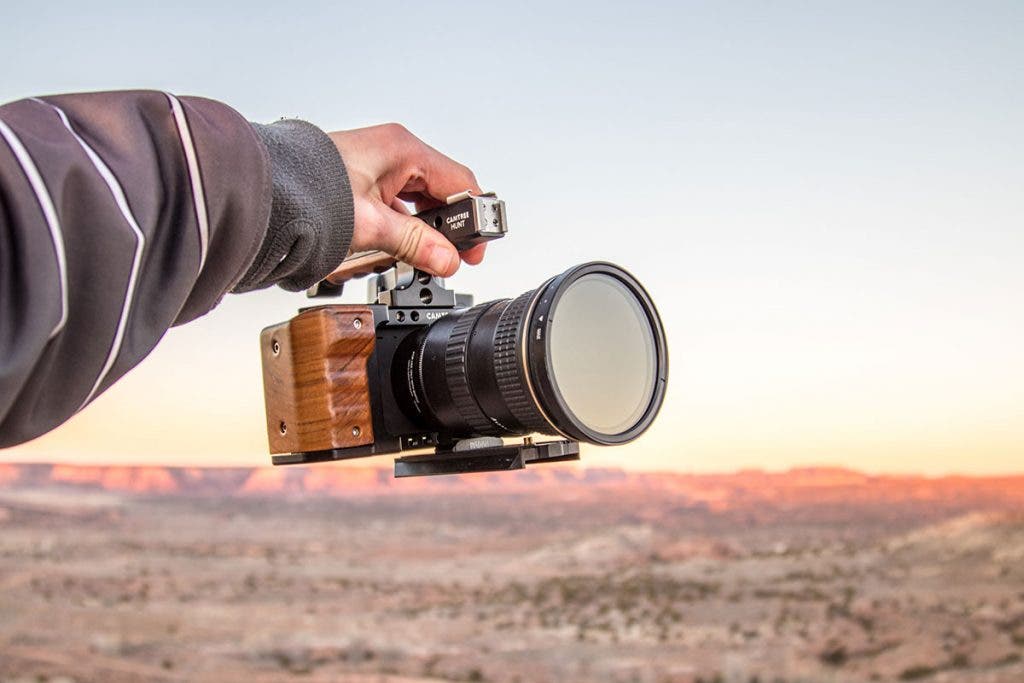
Camera lens filters can help you get creative looks and they can also help you shoot in less-than-ideal settings. The first filter you should get is a variable ND filter. The Tiffen Variable Neutral Density (ND) Filter – 2 to 8 Stop – is a favorite.
Variable ND filters use two polarizing filters which when rotated vary the amount of light passing through the lens to the sensor. This will allow you to shoot in super bright conditions while maintaining a wide-open aperture and a shutter speed that is double your frame rate (i.e. 24fps with 1/50 second shutter). As a rule of thumb, purchase filters for the largest diameter lens you have or plan on getting and then use step-up rings to fit them onto your smaller diameter lenses.
Check out these other great filters and video camera accessories to improve your video kit’s flexibility and functionality:
B + W Circular Polarizer Multi Coated Filter
The effect of a polarizing filter cannot be reproduced, it is therefore an extremely important filter to have. Polarizing filters can reduce reflections and glare and make colors truly pop. When your camera is pointed at a reflective surface and the light is reflecting into the camera at certain angles near 90 degrees using a polarizing filter will greatly reduce the glare and allow you to see much more clearly through the reflections.
Without the polarizer, there is no way to later remove it. Polarizing filters also make certain colors more saturated, such as the blue of a sky or the green leaves of a tree. With a little trial and error, hopefully in combination with a little research, you will see the great effects that you can achieve with this filter.
As a word of caution though, when using wide angle lenses you may see inconsistencies in your pictures, especially in the sky, as the light from the sun will be hitting the sky at different angles. You can either use a more telephoto lens, try to reframe the shot, or rotate the filter until the light looks natural.
Lens Adapter Rings
B + W Step-Up Adapter Rings
Step-Up rings will allow you to adapt your filters from your largest diameter lens down to the smallest. You just need the correct one. This saves you from having to buy multiple versions of the same filters which would be very expensive! Step up rings vary in materials and craftsmanship. While they are just a little threaded ring, if you get a cheap one you may find it getting stuck. Rings made of brass are of high quality and much better than aluminum or plastic.
Tiffen Belt Style Filter Pouch
A very useful video camera accessory, keeping your filters on your belt lets you switch them in and out very quickly. Much easier than digging through your bag.
Matte Box Filters
On film sets Matte Boxes and rectangular or square filters are the norm. Matte Boxes are filter holders which also block unwanted light from entering the lens using attached flags. Matte boxes allow for quicker changing of filters, doubling up of filters, and in the case of swing away matte boxes allows you to more quickly change lenses without changing any light filtration.
Tiffen 4×4″ (4mm Thick) DV Select Filter Kit 3
This set of 3 filters is a great start for those looking to get 4” X 4” filters. The ProMist filter lowers the values of highlights and takes away some of the contrast from the image. There is also some blooming around bright lights in the frame. This filter helps you get a softer look and can often help with emulating a filmic look. It is also useful for softening the look of skin.
6. Camera Stabilization and Movement
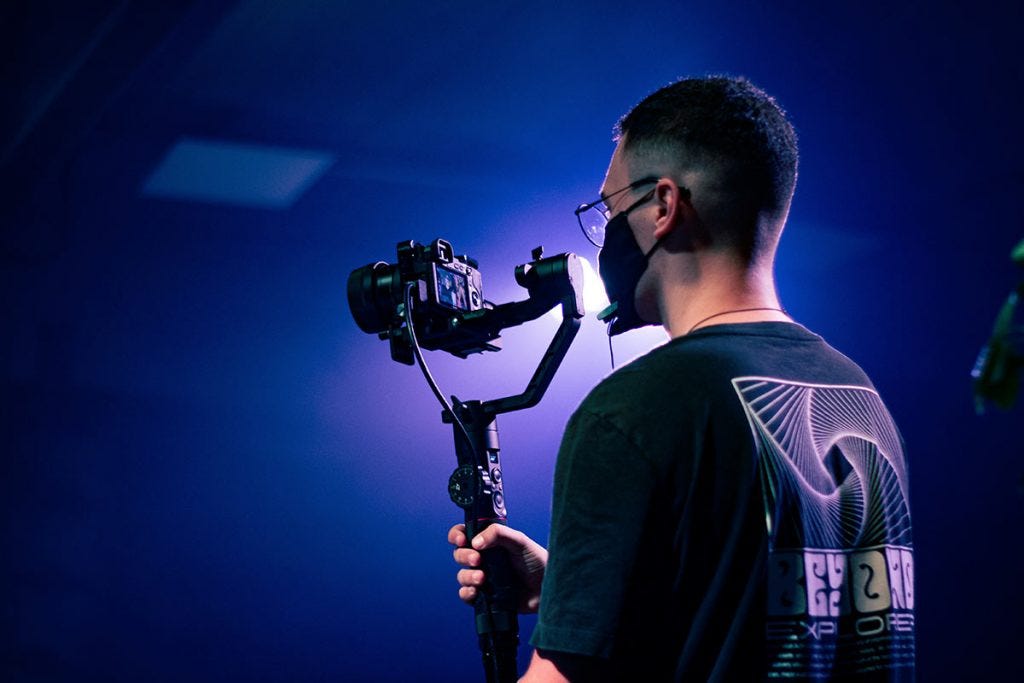
Once you have a little bit of budget for camera movement, consider getting a slider. Like any tool, it should be used with purpose, not just because you have it. The next tool that will help you get interesting shots is a gimbal. Gimbals are great for tracking shots. You can also get a drone to give you aerial shots which can give your images a cool perspective that you wouldn’t get otherwise. Just make sure to practice, read the instructions and learn if you need any certifications before you need to use one for a shoot.
Manfrotto Professional 3-Axis Handheld Modular Gimbal
It’s rare to find a gimbal capable of accommodating a full-size DSLR that’s both affordable and high quality. The Manfrotto Professional 3-Axis Handheld Modular Gimbal delivers exactly what videographers need from a handheld gimbal without breaking the bank.
You can control precise movements, focusing, and shooting with the built-in LCD touch screen or from the companion app. Independently locking axes provide improved specificity and gear safety. Plus, the pre-programmed modes make it easy to capture a variety of footage.
Whether you use the timelapse, inception, panorama, portrait, or selfie mode, you’ll quickly fall in love with this fantastic and reliable gimbal.
Syrp Magic Carpet Short Slider Kit with 60cm Track, Carriage and End Caps
Elevate your footage with smooth and precise professional tracking movements by adding the Syrp Magic Carpet Short Slider Kit to your video equipment collection.
This compact and impressive slider kit features quick-release adjustable legs, high-precision ball-bearing rollers for smooth, even movement, and a counterweight roller system for vertical shooting.
You can use the Magic Carpet Short Slider Kit as a standalone tracking kit for basic production needs, or you can combine it with other Magic Carpet systems for even greater control and flexibility.
While this system isn’t motorized, the simplicity and smoothness of the shots you can achieve will provide plenty of room for creativity.
7. Grip and Gaff Gear
Modifying lighting to get a more pleasing image is one of the key talents of great gaffers and cinematographers. Even if you are shooting interviews, knowing how to use lighting modifiers will get you a much better lit scene that will flatter your talent and lead to happier clients. The below are a small sampling of gear that can be used to get better lighting and have your image looking significantly better.
Digital Juice 20×24″ Diffusion Gel Kit
A set of diffusion will help you soften your lights. This set has varying levels which should help you dial in the right amount of softness depending on the image you are looking for.
Digital Juice 20×24″ Color Correction Gel Kit
Having a set of gels on hand to be able to match color temperatures is a must. This set allows you to balance daylight to tungsten lights, vice versa and also control green spikes from fluorescents.
Kupo 24×36″ Open End Flag Kit
Lighting flags and nets modify the look and feel of artificial lighting sources. When you need to soften, cut, or reshape light, it’s a good idea to invest in a versatile kit like the Kupo 24×36” Open End Flag Kit.
All six included flags feature a 9.5mm rod welded into the frame and stitched into the fabric for ideal sturdiness. Store and transport your flag kit easily and safely with the included protective carrying bag.
Cinefoil, also known as black wrap, is a multi-purpose tool made out of matte black aluminum for blocking light from spilling onto areas where it is not wanted. It is heat resistant so it can be placed around hot lights. Cinefoil is not only used for stopping spill light, it can also be used to snoot a light, which means to create a small channel in front of a light making a smaller beam that can isolate a subject in the frame more precisely. Cinefoil can also be used to create window patterns on backgrounds by cutting slits into a sheet and placing it in front of a light. This is a very versatile tool.
8. External Monitor/Recorder
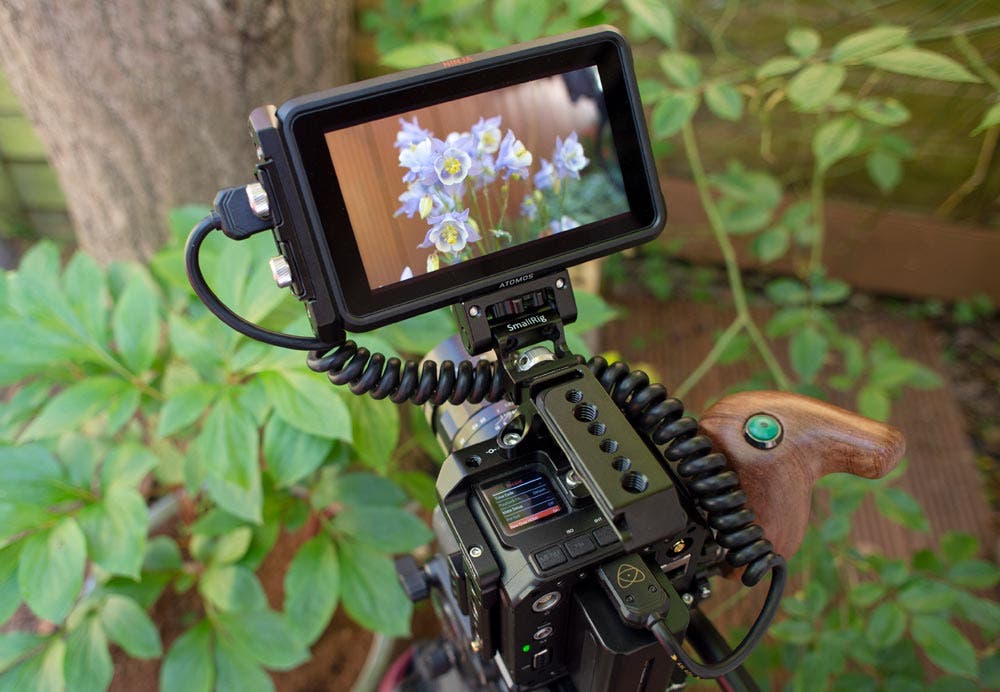
While the codecs that DSLRs and mirrorless cameras record in are getting better, they are still usually very compressed and don’t hold up nearly as well to image manipulation in post as their cinema brethren. Using an external recorder with a camera that outputs a clean HDMI signal will allow you to get a higher quality recording. The maximum quality will of course depend on both your camera’s capabilities as well as the recorder’s.
Atomos Ninja Ultra 5.2″ Touchscreen HDR Monitor-Recorder
The Atomos Ninja Ultra is designed for use with DSLR or mirrorless cameras, offering advanced monitoring abilities and RAW recording never before seen on an Atomos monitor-recorder. It can capture in ProRes RAW up to 8K 30P, 6K 60P & 4K 120P, and has flexible codec options also including ProRes, DNxHD & H.265 (HEVC). It can even record simultaneously in ProRes RAW and H.265 for those looking to utilize a Camera to Cloud workflow.
This monitor-recorder also features the new AtomOS 11 operating system, which has improved memory management and response times compared to other Atomos models. You’ll also have a stronger connectivity with Wi-Fi 6E and RemoteView availability for optimal viewing wherever you are.
Atomos Ninja V 5″ Touchscreen Recording Monitor, 1980×1080, 4K HDMI Input
Filmmakers looking for a reliable recording monitor at a reasonable price point should consider investing in the Atomos Ninja V 5” Touchscreen Recording Monitor.
Using this monitor effectively overrides your camera’s internal video duration limits, so you can record for as long as you need without worrying about cuts and split files. Imagine recording at 4K resolution for up to 2.5 hours!
The Ninja V also offers improved viewing of your footage as you shoot thanks to 10+ stops of dynamic range on an edge to edge anti-reflection screen. You’ll love being able to shoot in full daylight while also predicting how your resulting footage will look!
Blackmagic Design Video Assist 7″ 12G-SDI HDMI HDR Recording Monitor
For a bit more screen real estate and a few extra features, check out Blackmagic Design’s Video Assist 7” 12G-SDI HDMI HDR Recording Monitor.
With this monitor you can bypass your camera’s recording slots and instead record footage to SDHC/XC memory cards or an external drive for additional storage flexibility. Powered by Sony L-series batteries, the Video Assist features two battery slots so you can swap out batteries any time — even in the middle of a take.
The 7” high brightness touch screen makes viewing and setting adjustments a breeze even in the brightest shooting conditions.
Check out our hands-on review of the Blackmagic Design Video Assist with creator Peter Dam.
9. Follow Focus

Tilta TT-03-GJ Rig Follow Focus Kit
Being able to get great focus pulls does not require a follow focus, but they can certainly help. The follow focus below is a great, well-built option that comes with many video camera accessories, including a great travel case. The Tilta TT-03-GJ rig, try saying that 5 times fast, is specifically designed for DSLR and mirrorless cameras. The only thing to note: this unit doesn’t work with cameras that have attached battery grips as the height is not adjustable.
10. Other Notable Video Camera Accessories
Calibrite ColorChecker Passport Photo 2
Save yourself the stress of correcting color casts, unattractive white balances, and exposure issues by using the Calibrate ColorChecker Passport Photo 2 on your next video shoot.
This kit features four targets in one portable package, including a standard 24 pack ColorChecker target, an enhancement target, a 12% gray target, and an 18% gray target. Dial in your color, check for highlight and shadow clipping, and perfectly adjust your exposure for every scene you shoot.
Calibrite even includes camera calibration software so you can quickly create individualized camera profiles to streamline your workflow. With additional third party software support for industry preferred programs, this kit is all you need to render accurate color.
11. Memory Cards and Batteries
If you don’t have enough battery power for your camera, audio equipment, lights, monitor/recorder to keep recording for the longest day you can image you aren’t really prepared. Make sure you always have enough of both batteries and memory cards to cover you. This may not be related to getting a better image, but if you run out of either you won’t be getting any image, so in a way, it kind of is.
SanDisk’s Extreme Pro CFexpress Type-B Memory Card is a reliable choice for Sony, Canon, Nikon, Panasonic, and other CFexpress compatible cameras. Not only do they feature some of the fastest write speeds on the market, but they won’t get bogged down when shooting in 4K.
If your DSLR or mirrorless camera takes SDXC cards, then Lexar Professional 2000x Cards are a great option to consider. They can easily manage video recording up to 4K and will speed up file transfers to your computer when backing up or reviewing footage.
Once you’ve found the perfect memory cards to keep your shoot going, it’s always a good idea to stock up on spare camera batteries and charging accessories. The last thing you want is to run out of juice during a shoot and have to hold production while you recharge!
Never Stop Learning, Always Be Creating
The best tool to improve your videos is to always be learning. Learn from carefully watching your videos and analyzing what could have been better, learn from YouTube videos, work for people who are better than you, join groups where people share knowledge.
Finally, before you start spending and get knee deep in gear, all the best gear in the world won’t make your videos great. How many multi-million dollar budgeted movies have you seen that were terrible? They had every piece of the most expensive gear available to them and a crew the size of an army. Gear is a tool to help you tell your story. The story is king.
Learn how to tell a better story using the equipment you have available to you. When you have the budget and see the need to invest in gear, it can indeed help you make your story better, but no matter what, nothing is more important than making sure your story works.
